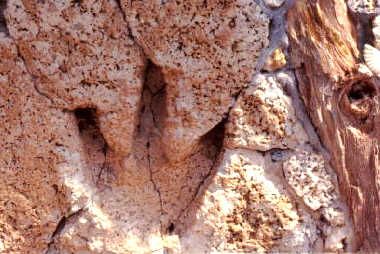
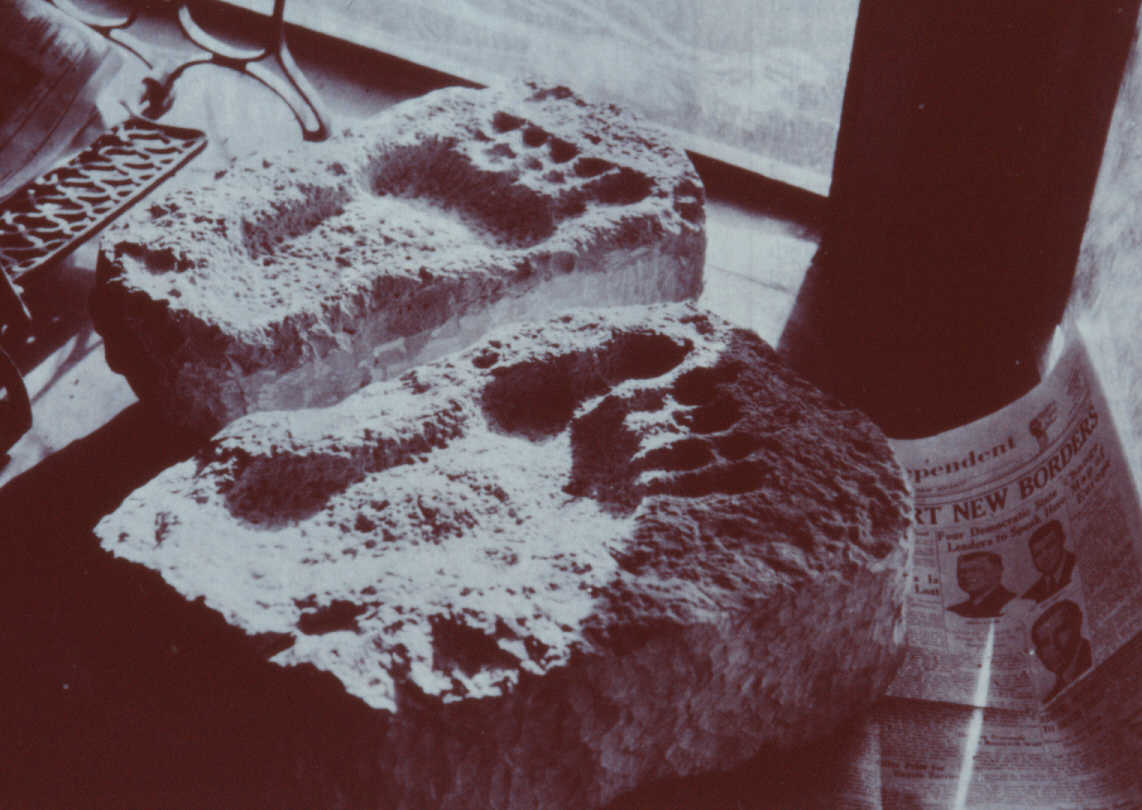
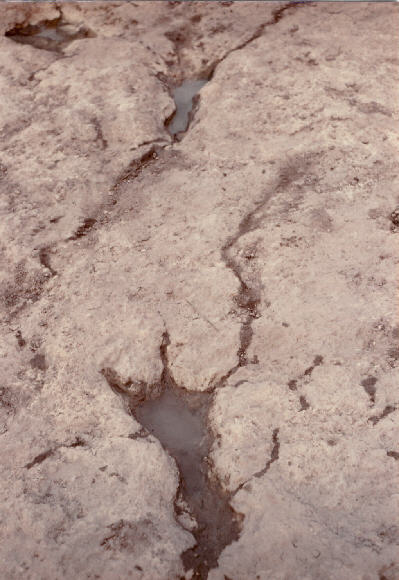
 |
| One of the first tracks removed from the Paluxy Riverbed, mounted in the bandstand of the town square in Glen Rose, Texas. Surrounding it are large pieces of petrified wood from overlying rock beds. |
| Fran, an Acrocanthosaurus atokensis skeleton, found in Oklahoma and now displayed at the North Carolina Museum of Natural History. This dinosaur probably made most of the theropod tracks in Glen Rose. |
 |
| The two loose "giant man track" slabs seen by Roland Bird in a Trading Post window, widely regarded as carvings. Note the very unnatural features, especially the multi-jointed toe marks. Two carved dinosaur tracks were also seen in the trading post window. |
 |
| A portion of a trail of metatarsal dinosaur tracks on the Alfred West Site. Such tracks, when eroded, mud-collapsed, or infilled, have often been mistaken for "giant man tracks." Track IIDW13 at bottom is one of the best preserved metatarsal tracks in the Paluxy, but the next track in sequence is more mud- collapsed and thus shows a less distinct, more human-like shape (and could become even more human like with erosion and/or infilling). |
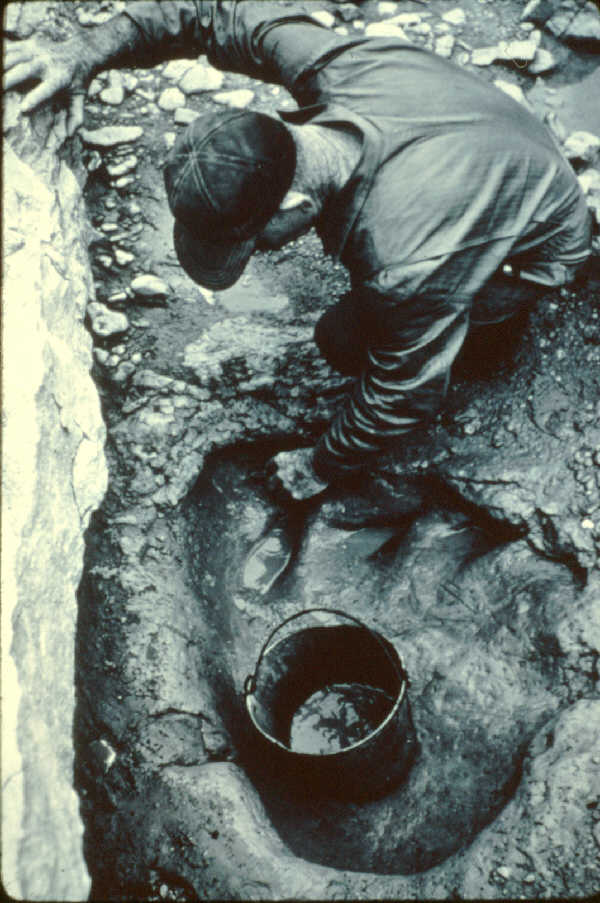 |
| Local Glen Rose resident Charlie Moss, cleaning a sauropod track, as one of the first workers in Dinosaur Valley State Park. Moss is credited with discovering the first sauropod tracks in Texas (although he evidently initially mistook the latter for ancient elephant tracks). Photo circa 1970, courtesy of Beatrice Moss. |
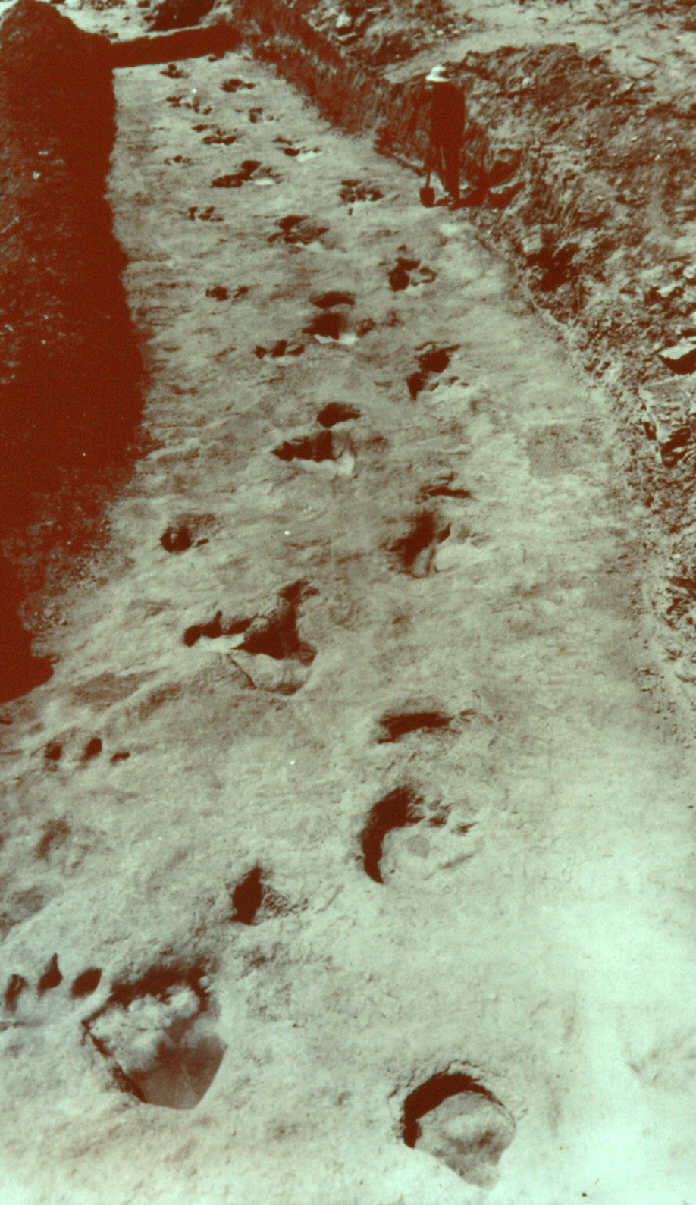 |
| The famous Paluxy trackways excavated by Roland T. Bird in 1939 and 1940. This has often been interpeted as an ancient chase scene, with the large four-footed sauropod dinosaur being attacked by a carnivorous theropod dinosaur. However, the paces are relatively short, suggesing that the carnosaur may simiply have been following the same path, or tracking the sauropod from a distance. |
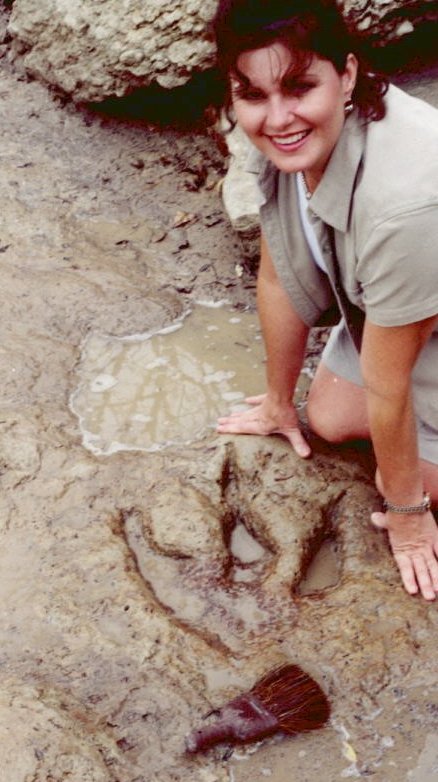 |
| Acrocanthosaurus track at Blue Hole in Dinosaur Valley State Park |
Around 1934 dinosaur prints of another kind, and larger than any previously found, were discovered in the Paluxy by local resident Charlie Moss. Although now known to be tracks of large, four-footed sauropod dinosaurs, they were evidently mistaken by Charlie and other locals for ancient elephant or mammoth prints. Meanwhile, a number of large elongate depressions found in the Paluxy were casually regarded as "giant man tracks"or "moccasin prints" local residents. In fact, one resident (George Adams) began to carve enhanced versions of such "man tracks" (with distinct but unnatural-looking toes) to tourists and passers-by, many of whom were coming to Glen Rose at that time for its restful "sanitariums" and mineral water. Another local resident (Jim Ryals) sold a number real dinosaur tracks to tourists, which he laboriously chiseled out of the riverbed.
However, the Paluxy tracks did not garner much attention from the outside
world until after a visit in 1938 by paleontologist Roland T.
Bird of the American Museum of Natural History. While returning
from a field expedition out west, Bird spotted some of Adam's carvings
(including both dinosaur and "human" track carvings) in a trading post
window near Gallup, New Mexico. Bird immediately recognized them as carvings,
but wondered what inspired the artist to make them. Upon inquiring about their
origin, was told that they came from the Glen Rose area. While in Glen
Rose, Bird not uncovered and documented many three-toed tracks,
but was amazed to also find immense tracks of four-legged sauropod
dinosaurs--some approaching the size of small bath tubs--which were
previously unknown to science. While many locals insist (and rightly so) that
Charlie Moss deserves credit for first finding such tracks, Bird was the
first to correctly identify them as sauropod tracks and bring them to
widespread attention.
During his Paluxy work Bird also examined some of the
elongate tracks called human or "moccasin" prints by locals.
He could not precisely identify such tracks, but felt
were made by some type of prehistoric reptile. As it turns out he
was on the right track. Aside from the carvings, most such "man tracks"
in the riverbed itself have been conclusively shown to be indistinct
or infilled forms of metatarsal dinosaur tracks--made
by theropod dinosaurs walking in an unusual plantigrade or
"heel-down" manner. (Other alleged human tracks include a variety
of ambiguous and erosional markings).
During the next two years, using a team of local workers hired under a a WPA project, Bird exposed a long section of the riverbed with numerous parallel trails of sauropod tracks (indicating a herding behavior) as well as a long trail of theropod tracks following the same path, often interpreted as an ancient chase scene. Contending with a fickle river that often flooded after each rain and using sandbags to hold back the water, Bird and crew managed to chisel out several striding sequences of the now famous trackways. One sequence went to the American Museum, where after sitting in storage for many years, it was carefully reassembled and mounted under a sauropod skeleton. Other sections went to several other museums and universities. Bird reported his findings in series of popular articles in Scientific American and National Geographic, catapulting the little town of Glen Rose into instant fame.
Despite the increased public attention, the Paluxy tracks again fell into a period of neglect among scientists. Little serious work was done on the tracks from the mid-1940's through the late 1960's. However, in 1968 the land surrounding the Bird quarry was purchased by the state and declared a National Landmark, and in 1972 Dinosaur Valley State Park opened to the public. Meanwhile, the during the 1970's the human track claims were revived and expanded by a number of strict creationists, some of whom made a film proclaiming a number of elongate depressions were clear human footprints, supposedly refuting evolution and the conventional geologic timetable.
During the 1980's more serious mapping and analysis of the tracks began in Glen Rose, as it did on many other track sites throughout the world. As Indiana paleontologist James Farlow began further documentation and naming of the sauropod tracks, I and other workers systematically studied and mapped many of the predominantly theropod tracksites, and resolved the true nature of the alleged human tracks--showing that most were forms of metatarsal dinosaur tracks, while others were carvings and still others erosional markings or ambiguous sedimentary features. In the wake of such reports and evidence most "man track" proponents backpedaling from their claims, although a few individuals continue to promote them. Among them is local resident Carl Baugh, who runs a little creationist museum about a mile south of Dinosaur Valley State Park.
During the 1980's Dinosaur Valley also expanded its facilities, developing an interpretive center with replicas of part of Bird's trackways. It is one of the best attended parks in Texas. Recently the park has purchased additional land west of the previous border; the riverbed in this area includes many of the distinct, infilled metatarsal tracks, one of the longest trails in the Paluxy, a long sequence of small dinosaur tracks, and other interesting prints. Plans for further development include a full scale museum to replace the current interpretive center. I am currently working with Texas Parks and Wildlife to mark precise GPS coordinates for all known sites, and to develop an interactive web application that will feature diagrams, measurements, and photographs of all major tracksites in Dinosaur Valley State Park as well as other localities.
Dinosaur Valley State Park is located just a few miles west of Glen Rose proper, in Somervell County. Covering over 1500 acres, the park not only exhibits some of the best dinosaur tracks in the world (including the best preserved sauropod tracks anywhere), but also features opportunities for camping, fishing, swimming, and viewing beautiful scenery and wildlife. DVSP is open year round, but late summer is the best time to visit for viewing the tracks, when the river level is generally low.
Dinosaur Valley State Park
Phone: 254-897-4588
Park Road 59, P.O. Box 396
Glen Rose, TX 76043
For more information on the Paluxy tracks and Dinosaur Valley State Park, please visit http://paleo.cc/paluxy/.
File: glenrose.htm, 7 Jul 2005, GJK